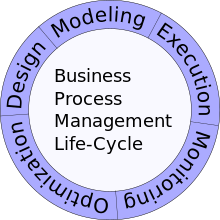Business Process Management or BPM is the practice of improving business processes by using various methods of modeling, execution, control, automation, measurement, and optimizing business activity flow. [1] Through BPM, businesses can thrive as BPM helps business manage their management process in an organized matter.
BPM is not task management, it focuses on ongoing and repetitive processes that follow a predictable pattern and from there, businesses can use these patterns to help with their business management, while task management focuses on organizing a certain set of activities, not patterns. [2] The goal of BPM is to improve repetitive processes. Through BPM you view your business as a set of processes which you can alter over time after evaluating the repetitive patterns in your business.[3]
BPM systems are not just one type or method as there are various different types to fit the needs of any type of business. System-Centric BPM or Integration-Centric BPM is a business process management system which does not involve much human interaction and its' primary function is to handle processes that depend on existing business systems. [4] Human-Centric BPM is also another system used frequently in businesses, its primary function is to consider customers first and are primarily executed by humans as automation is not able to complete this function as easily as humans.[5] Individuals are able to handle people or their customers better than an automated BPM as humans know humans.
BPM contains various methods to fit your business needs, but the activities involved to help the BPM go smoothly. The five activities are design, model, execute, monitor, and optimize.[6] During step one, the design stage, it centers around collecting date and forming a collection of the data in order to process it. The second step is model, during this stage a business works on fixing details such as deadlines in order to have a clear idea of the schedule for the BPM and data process. The third step, the execute stage, is used to test out the process to see how well it does before opening it up for everyone in the business, this stage allows for problems to be solved before finalizing this process. The fourth stage is the monster, during this stage the primary goal is to continue watching your process as it runs throughout the workflow, with this stage you can begin to measure efficiency. The fifth and final stage is optimize, this stage is made for final revisions and changing any details to in order to make it the most efficient process. These steps all work in harmony to help businesses effectively create a BPM system that works best for them.

This page is a redirect. The following categories are used to track and monitor this redirect:
|